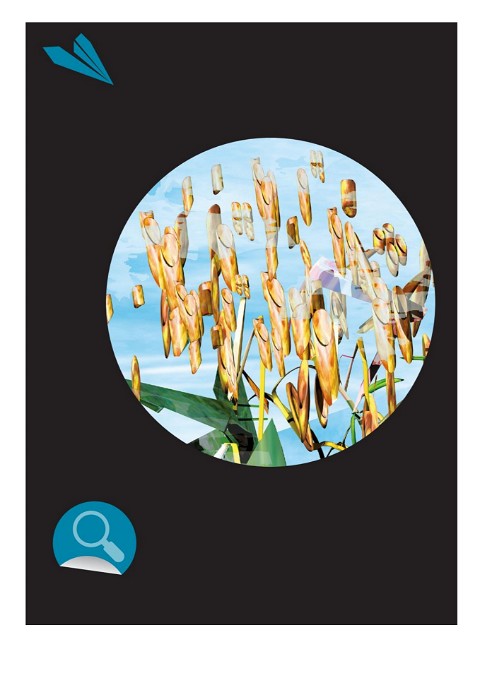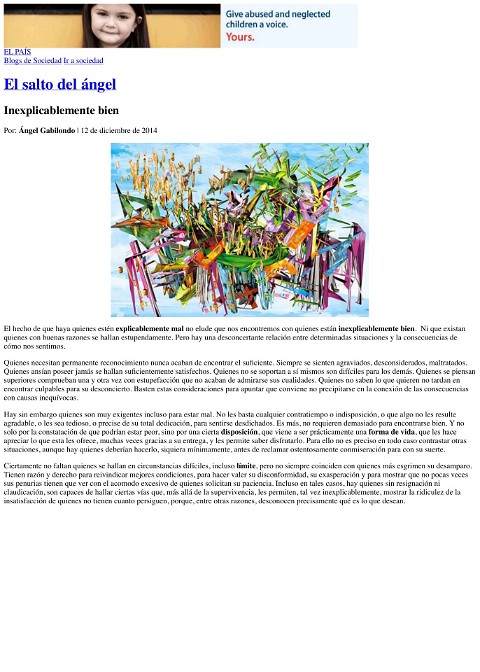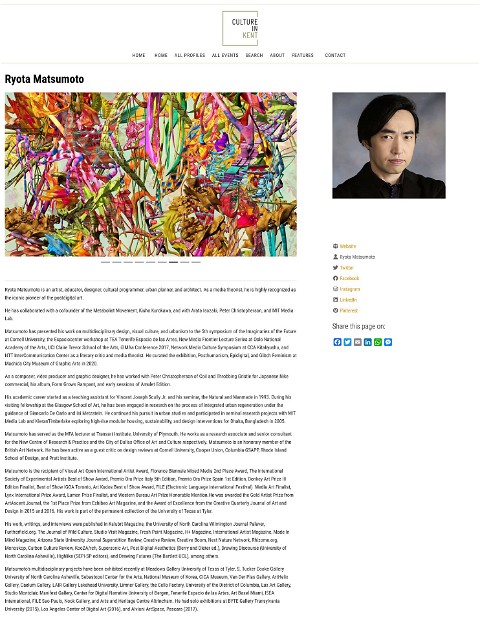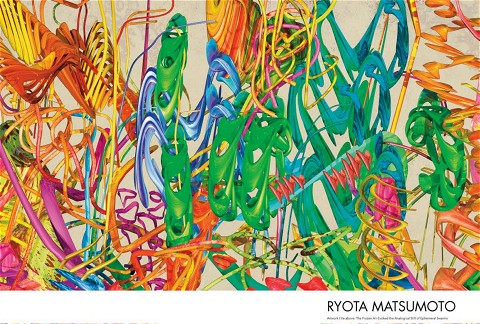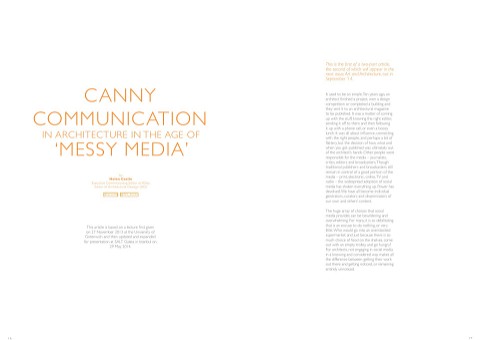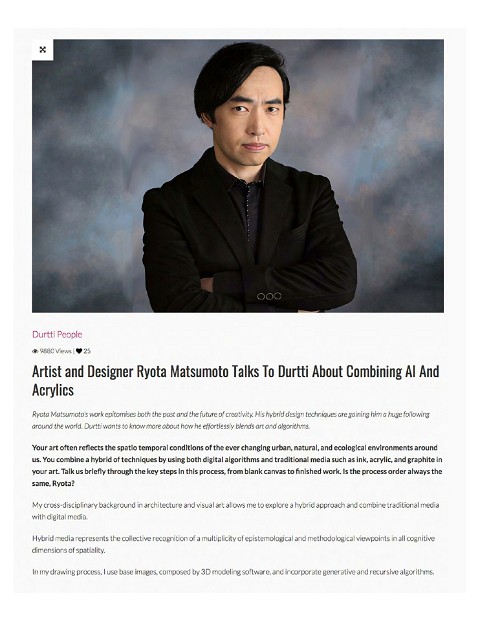Designer Interview Ryota Matsumoto | Faburry Gallery July 2016
>100 Views
October 24, 23
スライド概要
Ryota Matsumoto (松本良多) is an artist, educator, designer, cultural programmer, urban planner, and architect. As a media theorist, he is highly recognized as the iconic pioneer of the postdigital culture.
He has collaborated with a cofounder of the Metabolist Movement, Kisho Kurokawa, and with Arata Isozaki, Peter Christopherson, and MIT Media Lab.
Matsumoto has presented his work on multidisciplinary design, visual culture, and urbanism to the 5th symposium of the Imaginaries of the Future at Cornell University, the Espaciocenter workshop at TEA Tenerife Espacio de las Artes, New Media Frontier Lecture Series at Oslo National Academy of the Arts, UCI Claire Trevor School of the Arts, iDMAa Conference 2017, Network Media Culture Symposium at CCA Kitakyushu, and NTT InterCommunication Center as a literary critic and media theorist. He curated the exhibition, Posthumanism, Epidigital, and Glitch Feminism at Machida City Museum of Graphic Arts in 2020.
As a composer, video producer and graphic designer, he has worked with Peter Christopherson of Coil and Throbbing Gristle for Japanese Nike commercial, his album, Form Grows Rampant, and early sessions of Amulet Edition.
His academic career started as a teaching assistant for Vincent Joseph Scully Jr. and his seminar, the Natural and Manmade in 1993. During his visiting fellowship at the Glasgow School of Art, he has been engaged in research on the process of integrated urban regeneration under the guidance of Giancarlo De Carlo and Isi Metzstein. He continued his pursuit in urban studies and participated in seminal research projects with MIT Media Lab and KieranTimberlake exploring high-rise modular housing, sustainability, and design interventions for Dhaka, Bangladesh in 2005.
Matsumoto has served as the MFA lecturer at Transart Institute, University of Plymouth. He works as a research associate and senior consultant for the New Centre of Research & Practice and the City of Dallas Office of Art and Culture respectively. Matsumoto is an honorary member of the British Art Network. He has been active as a guest critic on design reviews at Cornell University, Cooper Union, Columbia GSAPP, Rhode Island School of Design, and Pratt Institute.
Matsumoto is the recipient of Visual Art Open International Artist Award, Florence Biennale Mixed Media 2nd Place Award, The International Society of Experimental Artists Best of Show Award, Premio Ora Prize Italy 5th Edition, Premio Ora Prize Spain 1st Edition, Donkey Art Prize III Edition Finalist, Best of Show IGOA Toronto, Art Kudos Best of Show Award, FILE (Electronic Language International Festival) Media Art Finalist, Lynx International Prize Award, Lumen Prize Finalist, and Western Bureau Art Prize Honorable Mention.He was awarded the Gold Artist Prize from ArtAscent Journal, the 1st Place Prize from Exhibeo Art Magazine, and the Award of Excellence from the Creative Quarterly Journal of Art and Design in 2015 and 2016. His work is part of the permanent collection of the University of Texas at Tyler.
His work, writings, and interviews were published in Kalubrt Magazine, the University of North Carolina Wilmington Journal Palaver, Furtherfield.org, The Journal of Wild Culture, Studio Visit Magazine, Fresh Paint Magazine, H+ Magazine, International Artist Magazine, Made In Mind Magazine, Arizona State University Journal Superstition Review, Creative Review, Creative Boom, Next Nature Network, Rhizome.org, Monoskop, Carbon Culture Review, KooZA/rch, Supersonic Art, Post Digital Aesthetics (Berry and Dieter ed.), Drawing Discourse (University of North Carolina Asheville), Highlike (SEPI-SP editors), and Drawing Futures (The Bartlett UCL), among others.
Matsumoto’s multidisciplinary projects have been exhibited recently at Meadows Gallery University of Texas at Tyler, S. Tucker Cooke Gallery University of North Carolina Asheville, Sebastopol Center for the Arts, National Museum of Korea, CICA Museum, Van Der Plas Gallery, ArtHelix Gallery, Caelum Gallery, LAIR Gallery Lakehead University, Limner Gallery, the Cello Factory, University of the District of Columbia, Lux Art Gallery, Studio Montclair, Manifest Gallery, Center for Digital Narrative University of Bergen, Tenerife Espacio de las Artes, Art Basel Miami, ISEA International, FILE Sao Paulo, Nook Gallery, and Arts and Heritage Centre Altrincham. He had solo exhibitions at BYTE Gallery Transylvania University (2015), Los Angeles Center of Digital Art (2016), and Alviani ArtSpace, Pescara (2017).
関連スライド
各ページのテキスト
July 2016 Exhibition — Faburry Gallery 2016/08/02 2:26 JULY 2016 EXHIBITION HOME INTERVIEWS SUBMIT PROMOTE A FRIEND ABOUT RYOTA MATSUMOTO Matsumoto’s work reflects the morphological transformations of our ever-evolving urban and ecological milieus, which could be attributed to a multitude of spatio-temporal phenomena influenced by social, economic and cultural factors. They are created as visual commentaries on speculative changes in notions of socities, cultures and ecosystems in the transient nature of constantly shifting topography and geology. The artworks explore the hybrid technique combining both traditional media (ink, acrylic, and graphite) and digital media (algorithmic processing, parametric modeling, data transcoding and image compositing with custom software ). The varying scale, juxtaposition of structural and amorphous forms, intertwined textures, oblique projections and visual metamorphoses are employed as the multi-layered drawing methodologies to question and investigate the ubiquitous nature of urban meta-morphology, the Anthropocene, and their visual representation in the context of nonEuclidean configuration. Furthermore, the application of these techniques allow the work to transcend the boundaries between analog and digital media as well as between twoand multi-dimensional domains. His compositional techniques imbue the work with what we see as the very http://www.faburrygallery.com/julyexhibition/#/nebel/ 1/3 ページ
July 2016 Exhibition — Faburry Gallery 2016/08/02 2:26 essence of our socio-cultural environments beyond the conventional protocols of architectural and artistic formalities, and that they conjure up the synthetic possibilities within which the spatial and temporal variations of existing spatial semiotics emerge as the potential products of alchemical procedures. Read Interview Back to July 2016 Exhibition prev / next MICHELE KISHITA JESSICA BRILLI APRIL ZANNE JOHNSON SUSAN CARR RICHARD GIANNOTTI REBECCA CHITTICKS http://www.faburrygallery.com/julyexhibition/#/nebel/ 2/3 ページ
- http://www.faburrygallery.com/julyexhibition/#/nebel/
- http://www.faburrygallery.com/artists/2016/7/6/ryota-matsumoto
- http://www.faburrygallery.com/julyexhibition/#
- http://www.faburrygallery.com/michelekishita/
- http://www.faburrygallery.com/weite/
- http://www.faburrygallery.com/aprilzannejohnson/
- http://www.faburrygallery.com/susancarr/
- http://www.faburrygallery.com/maritime/
- http://www.faburrygallery.com/weg/
July 2016 Exhibition — Faburry Gallery 2016/08/02 2:26 ERIKA STEARLY MARIE TOSTO JENNY BROWN RYOTA MATSUMOTO Terms and Condition Privacy Policy http://www.faburrygallery.com/julyexhibition/#/nebel/ 3/3 ページ
- http://www.faburrygallery.com/julyexhibition/#/nebel/
- http://www.faburrygallery.com/erikastearly/
- http://www.faburrygallery.com/marietosto/
- http://www.faburrygallery.com/jennybrown/
- http://www.faburrygallery.com/nebel/
- http://www.faburrygallery.com/terms-and-conditions
- http://www.faburrygallery.com/privacy-policy
Ryota Matsumoto — Faburry Gallery 2016/08/02 2:27 JULY 2016 EXHIBITION HOME INTERVIEWS SUBMIT PROMOTE A FRIEND ABOUT LATEST POSTS MICHELE KISHITA Jul 11, 2016 ERIKA STEARLY Jul 11, 2016 JENNY BROWN Jul 11, 2016 JESSICA BRILLI Jul 11, 2016 APRIL ZANNE JOHNSON Jul 11, 2016 RYOTA MATSUMOTO SUSAN CARR Jul 11, 2016 July 11, 2016 Matsumoto’s work reflects the morphological transformations of our ever-evolving urban and RICHARD GIANNOTTI Jul 11, 2016 ecological milieus, which could be attributed to a multitude of spatio-temporal phenomena influenced by social, economic and cultural factors. They are created as visual commentaries REBECCA CHITTICKS on speculative changes in notions of socities, cultures and ecosystems in the transient nature Jul 11, 2016 of constantly shifting topography and geology. The artworks explore the hybrid technique combining both traditional media (ink, acrylic, and MARIE TOSTO Jul 11, 2016 graphite) and digital media (algorithmic processing, parametric modeling, data transcoding and image compositing with custom software ). The varying scale, juxtaposition of structural and amorphous forms, intertwined textures, RYOTA MATSUMOTO Jul 11, 2016 oblique projections and visual metamorphoses are employed as the multi-layered drawing methodologies to question and investigate the ubiquitous nature of urban meta-morphology, the Anthropocene, and their visual representation in the context of non-Euclidean configuration. Furthermore, the application of these techniques allow the work to transcend the boundaries between analog and digital media as well as between two- and multidimensional domains. His compositional techniques imbue the work with what we see as the very essence of our socio-cultural environments beyond the conventional protocols of architectural and artistic formalities, and that they conjure up the synthetic possibilities within which the spatial and http://www.faburrygallery.com/artists/2016/7/6/ryota-matsumoto 1/4 ページ
- http://www.faburrygallery.com/artists/2016/7/6/ryota-matsumoto
- http://www.faburrygallery.com/artists/2016/6/26/michele-kishita
- http://www.faburrygallery.com/artists/2016/6/26/erika-stearly
- http://www.faburrygallery.com/artists/2016/7/4/jenny-brown
- http://www.faburrygallery.com/artists/2016/7/4/jessica-brilli
- http://www.faburrygallery.com/artists/2016/7/4/april-zanne-johnson
- http://www.faburrygallery.com/artists/2016/7/5/susan-carr
- http://www.faburrygallery.com/artists/2016/7/5/richard-giannotti
- http://www.faburrygallery.com/artists/2016/7/5/rebecca-chitticks
- http://www.faburrygallery.com/artists/2016/7/5/marie-tosto
- http://www.faburrygallery.com/julyexhibition/
- http://www.faburrygallery.com/
- http://www.faburrygallery.com/artists/
- http://www.faburrygallery.com/submit/
- http://www.faburrygallery.com/friends/
- http://www.faburrygallery.com/about-1/
Ryota Matsumoto — Faburry Gallery 2016/08/02 2:27 temporal variations of existing spatial semiotics emerge as the potential products of alchemical procedures. Ryota Matsumoto is a principal and founder of an award-winning interdisciplinary design office, Ryota Matsumoto Studio based in Tokyo. He is an artist, designer and urban planner. He received a Master of Architecture degree from University of Pennsylvania in 2007 after his studies at Architectural Association in London and Mackintosh School of Architecture, Glasgow School of Art in early 90’s. He currently serves as an advisor and adjunct faculty member of Transart Institute in Berlin and New York. His art and design work are featured in numerous publications and exhibitions worldwide. http://www.ryotamatsumoto.com You have successfully mastered multiple creative fields: art, design and architecture. Tell us about how you balance all three interests. It seems to me the boundaries between art and design disciplines are no longer of any significance and they tend to blur more often than not. As far as my personal experience as a designer is concerned, we tend to work as a bridging point among various disciplines. From our formative years, we are trained to pick things up quickly from different fields and apply them to resolve any emerging issues. In that respect, interdisciplinary thinking comes naturally to me and I always find the way to break down barriers between fields rather than balancing between them to cultivate common ground, even when I am engaged in art or design-related fields. How do you manage your time in the studio? What is your best advice for maximizing your schedule? I firmly believe that creativity comes out of a whirlpool of chaos. So what I always do is jotting down or drawing whatever pops into my head. Then I create associations among random words or drawings. It is probably similar to surrealists’ exquisite corpse in terms of a creative process. It allows you to take up any mundane ideas and to turn them into something inventive in spite of your limited time and tight schedule. To me, maximizing schedule is tantamount to seeking effective ways to think outside the box. Explain the process behind your paintings. What inspires you? My blended background in architecture and visual art leads me to explore the hybrid approach, whereby I combine the traditional media (ink, acrylic, and graphite) and digital media (algorithmic processing, parametric modeling, generative design, data transcoding and image compositing with custom software ). The technique allows me to instill a warm human touch and painterly, organic feels to otherwise cold and detached precision of digital drawings. I am deeply affected by the deterioration and transformation of our urban and ecological milieus that are often attributed to emerging realities of the Anthropocene, the gamut of environmental issues, and the multitude of spatial practices constructed by different societies over centuries. These agendas are what I would like to address through my work and interdisciplinary research. How much planning does each work require? I don’t plan much beforehand. I prefer to take an unexpected trip that might lead me down an unpredictable path. Spontaneity is a crucial element to keep the tension and freshness in my work, especially when I work with digital media which is often associated with formalistic rigidity. http://www.faburrygallery.com/artists/2016/7/6/ryota-matsumoto 2/4 ページ
Ryota Matsumoto — Faburry Gallery 2016/08/02 2:27 What are your favorite activities when you are not working? I like to travel a lot, discover a new place and meet people from a different cultural and professional background, whenever time allows. I never have chance to settle down and live a life of constant travel since my childhood. So far, this lifestyle proves to be a great learning experience. What advice would you give artists for promoting their work ? I, myself am still searching for the way to promote my work. I gather online galleries and social networking sites have the potential to not only promote the work of emerging talents but facilitate interaction, communication, and collaboration especially among multimedia artists. Share 0 Likes ← Marie Tosto http://www.faburrygallery.com/artists/2016/7/6/ryota-matsumoto 3/4 ページ
